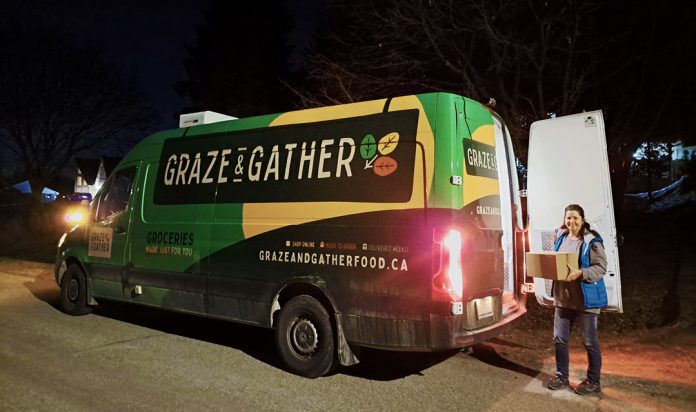Amid uncertain times with tariffs and trade, many Canadians are trying to find local alternatives to everyday products. Although the tariffs haven’t affected groceries yet, people are also searching for Canadian foods. This has brought challenges of its own, including confusion surrounding ‘Made in Canada’ labels that companies seem to use very liberally.
For Dave Kranenburg, the push for local shopping is reminiscent of another memorable period in recent history – the COVID-19 lockdowns. Five years ago, Kranenburg knew he was about to lose his entire income source when upcoming lockdowns promised to shut down his dog boarding kennel and the farmers markets he relied on to sell his farm products.
To combat this, he set up an online storefront for himself and other farmers in his community. He says he had been working on the website before the pandemic, so he was able to get it running within a few hours of the lockdown being called. Some of the success was due to how quickly the site was up and running, according to Kranenburg, but he also noticed that once access to grocery stores became limited, people were more willing to explore alternatives including locally produced food.
“Where we shop and what we buy are deeply ingrained habits in us and changing from those habits is very, very difficult,” he says. “So the pandemic provided this little moment in time when people are like, ‘I’ve got to try something different,’ and they were open to something else.”
Since then, Kranenburg has grown his online site to include vendors from across Canada and around the world. Now, his company Graze & Gather services a wide swath of neighbourhoods including the majority of Durham Region and parts of the GTA.
Sargent Family Dairy is one of the farms that works with Graze & Gather to distribute their products. The farm produces Jersey milk, a unique type of milk that comes from Jersey cows. Their partnership with Graze & Gather has helped them expand because they don’t have the time or the system to facilitate door-to-door deliveries, according to co-owner Sharyn Sargent. She says the farm gets customers from as far as Toronto, and having the products available for delivery makes things much more convenient for them and helps encourage new customers to shop here.
In recent months, she says the tariffs have had a hand in driving business up.
“With all the discussions about tariffs and people looking for Canadian products, we’ve found that we’ve got a lot of new consumers coming in and a lot of new families looking for stuff closer to home rather than going to the big box store,” she explains.
Kranenburg says although he can’t be sure what the tariffs will do for the business, this trend is showing up at Graze & Gather as well. He has been seeing growing interest in challenging Canadian food policies like interprovincial trade and institutional food procurement. For example, changing what food institutions like hospitals and universities buy.
“There’s a lot more talk right now about how to remove some of these barriers that have been created over the last several decades so that it’s easier to buy and support Canadian food businesses,” he explains. “Maybe this is the moment in time when there’s enough political capital, social capital, to actually pursue these things in a very meaningful way.”
Aside from political interests and maintaining Canadian self-reliance, Kranenburg explains that shopping local can have a number of benefits. It shortens the supply chain, bringing food directly from the producer to the consumer without additional steps like packaging or processing. Buying from local shops also helps boost the local economy by putting money back into community investments – for example, farmers might use the money to hire workers from the community or buy supplies from nearby stores. This is in stark contrast with larger organizations like supermarkets, which typically use their profits to generate even more profit.
Small farmers benefit from this arrangement too. According to a 2023 study from Statistics Canada, common reasons for selling food locally included the social aspect of maintaining close community relationships, convenience and higher profits.
There’s another benefit Kranenburg has found that may be less obvious – the quality of the food. A lot of commercially-available food is mass-produced, harvested before its time and shipped thousands of kilometres. According to Kranenburg, the difference is noticeable when you compare supermarket food to a food that has been locally-grown by a sustainable farm. On top of taste, the nutritional quality of food has been declining due to the shift away from natural farming processes.
“Industrial farming is increasing yields, but when you look at the composition of some of those ingredients – across the board, key vitamins and minerals are just decreasing,” he says. “Versus sustainable organic farms where the nutritional quality is just high, so you’re actually getting a lot more taste and nutrition for your buck than you are out of mainstream or industrial food.”
The Sargent family has found this to be true on their farm. Sharyn explains customers often compliment the quality of the milk, saying it has a unique taste, or it reminds them of the less-processed milk they used to drink in the past.
“People trust our product because they know it is quality,” she says. “And I think that’s the biggest thing, that it’s a quality product and it’s fresh.”
In order to maintain this standard, Graze & Gather is guided by four key principles. The organizations they partner with need to be localized, regenerative, traceable and authentic. For Kranenburg, this means the farmers have ownership of their products and food system, their practices are sustainable for the farm and the larger community, they know where their ingredients are coming from, and they are genuine about their connection to the food.
This attention to sustainability and cultural authenticity ensures that Graze & Gather promotes holistic models and is productive for the communities it works in.
“I just don’t want any surprises, and I don’t want to be part of blatant or inadvertent food fraud in our society,” Kranenburg says.
In today’s era, with international trade so tightly woven into the Canadian economy, blatant and inadvertent food fraud can be surprisingly common. According to an article in The Conversation written by food systems experts, more than 95 per cent of Canadian beef is processed internationally, meaning that a lot of the economic benefits are seen abroad even for products labelled as Canadian.
The article also explains that one of the biggest challenges small farms face is distribution. They have difficulty getting their products into retail stores which can help increase customer reach. Graze & Gather sets out to change this by allowing customers to conveniently access local food options, and helping small farms and businesses with delivery.
The local food movement has existed for a long time, Kranenburg explains, but moving away from large supermarkets requires a significant shift in consumer habits. While the pandemic served as a great starting point for Graze & Gather’s online shopping model, for many people these latest trade conflicts might be the push they need to make the change.




